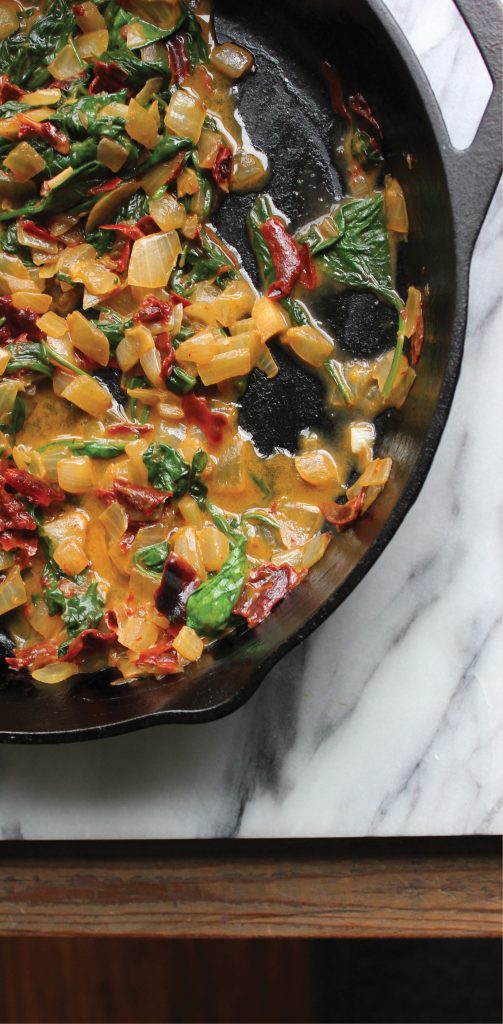‘Overwintered’ spinach is packed with flavor and nutrition
This time of year, spinach is so abundant one can cook with it by the handful. Spring spinach comes in waves, the first of which was planted last summer as a fall crop and coaxed through the winter under a blanket of snow. In spring, the overwintered spinach rages to life, with juicy leaves that are as sweet as they are lusty.
These leaves grew from roots that were well established last fall, as opposed to the second wave of spinach, planted months ago in greenhouses. It’s about the same size as the overwintered spinach but lacks the experience and terroir of the elder plants, which have had more time to accumulate nutrients.
Young spinach—including the so-called baby spinach that’s all the rage—is very convenient. It barely needs washing or any form of prep and is as tender as veal. It may not have the sweetness of an overwintered spinach, but neither does it have the bitterness.
In terms of nutrition, baby greens are “basically water,” explained a farmer friend of mine. “They aren’t as good for you as a plant that’s lived through the winter.”
He let me raid his field of overwintered spinach. The leaves were like plump, strong teenagers, in the prime of youth and vitality. Many of the stems were a vibrant shade of pinkish red, betraying their relatedness to chard, not to mention sugar beets. This is the stuff. Green gold. My friend’s spinach, which overwintered so beautifully, was Tyee variety. A spectacular way to enjoy the subtle complexity of an overwintered spinach is by making a very simple pesto with nothing more than spinach, olive oil and salt.
If your spinach is good but not quite top level, a more typical pesto with nuts, cheese, garlic and zest will be a very satisfying way to enjoy the season. I’ve also had great results by simply combining fresh spinach pesto au natural with year-old basil pesto from the freezer.
Salt Lake City urban farmers such as Kevin Nash (Earth First Urban Eco-Farms, 801-783-7822) often have overwintered spinach (as long as pests don’t get to it first, which happened this winter, according to Nash). By early April, Nash’s Viroflay spinach also will be ready. This heirloom variety grows leaves that can be the size of chard, he says.
The following recipe comes by way of friends in Bhutan, a little Buddhist country in the Himalayas, where chiles are king and cheese is queen, and all other foods are cooked in a combination thereof.
Those big bags of dried Mexican chiles that can be purchased in many box stores have become a lifeline to the Bhutanese diaspora. The iron in spinach, while abundant, isn’t always accessible to the consumer. Cooking spinach with foods that are high in vitamin C help make that iron more accessible. And chile pepper, it turns out, is high in vitamin C.
Bhutanese-style spinach with chile & cheese
1 to 3 ounces of dried red chile
4 handfuls of spinach
½ to 1 cup Mexican cheese blend
(or ¼-½ cup feta)
Salt (unless using feta)
Water or stock
Cooking oil
First, get the chile soaking. Rip out the stem ends of the pods, tearing off the good bits of flesh and discarding the stems, inner seed heads and as many seeds as you wish for the desired heat level. Tear up the leathery walls of the chile pods or leave them intact, depending on how avoidable you want the pepper pieces to be. Cover with water and soak.
Meanwhile, mince a medium-sized onion and sauté it in olive oil and maybe a little butter. Add the half-soaked chile and allow to cook, covered, with the onions. After about five minutes on medium heat, add 2 or 3 handfuls of spinach—as many as you can fit in the pan—in whole-leaf form. If things are on the dry side, add water or stock, a half-cup at a time, until the pan bubbles with deliciousness. Cover.
After about 5 minutes, the spinach will have cooked down. Add more spinach if you can push it in, ideally another handful or two, and then add the cheese—½ to 1 cup of Mexican blend, depending on how big your cheese tooth is. Some Bhutanese expats occasionally use feta—if so, mind the salt. Cover again for about 5 minutes, then stir until all the cheese has melted into the sauce.
Add more water or stock as necessary so it doesn’t dry out. If the cheese burns it will be a chewy, lumpy mess; but if the pan is properly hydrated, the cheese will dissolve into a luxurious cheesy gravy. Add salt to taste and serve with jasmine or basmati rice—or better yet, Bhutanese red rice.
Photos for the story are provided by Katherine Baumann.




